| How often have you skirted the question most often posed as you enter an antique shop - - "Are you looking for anything special?" If you're like me, you probably don't want to take the time away from your search because you know that it will only mean more questions - and who has time for that when there is glass waiting to be found - right?! |
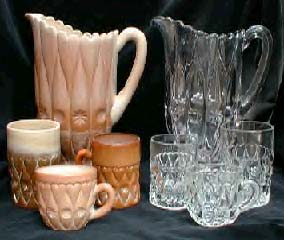 |
| Anyway, just to show that I'm not a totally insensitive boob, I've agreed to write this article to both make amends to any shop owner I've offended over the last five years, while hopefully informing others about my obsession - Greentown Glass. |
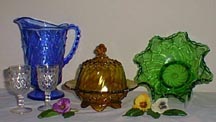 Cord Drapery pattern is rare in color. 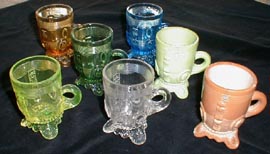 An assortment of colors in the Dewey pattern mugs. |
Actually, just
to keep the record straight, there is no company called Greentown Glass.
Those of us who belong to the National Greentown Glass Association (NGGA)
call glass manufactured by the Indiana Tumbler and Goblet Company of
Greentown, Indiana "Greentown Glass." When my conscience gets the best of me and I respond to the initial question, "Are you looking for anything special?" it is usually followed by, "Is it green glass?" The simple answer is yes, it is green, sometimes emerald green and more rarely nile green - an opaque green, but Greentown is probably most famous for its opaque brown or chocolate glass and its short lived Holly Amber - the only EAPG glass recognized by the Museum of Modern Art. |
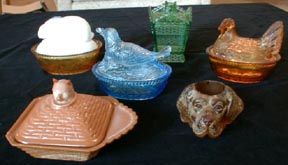 A
selection of Greentown's unique and rare novelties. |
So, what makes Greentown so sought after? Despite a relatively high production rate during its nine year existence (1894-1903), its unique patterns, clear glass clarity, outstanding colors, and unique animal covered dishes all contribute to its collectibility. |
| Three unique colors: chocolate, holly amber, and nile green - along with more traditional but still unique emerald green, amber, canary yellow, teal and cobalt blue also contribute to Greentown's success. At left is an assortment of very rare Nile green pieces. | 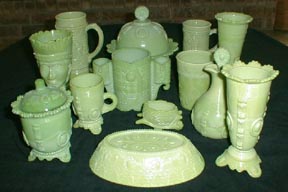 |
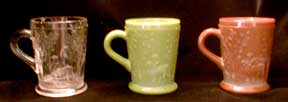 |
The very rare, Dog and Child mug has only been found in clear, nile green and chocolate. It shows a boy in the woods hugging his dog. It originally was used to fill with "packer's goods" and was covered with a metal cap. |
| We are happy to be able to share with you some of Pearl Lenon's rare Greentown novelties & covered animal dishes. On the Right are vaseline and emerald green Fighting Cocks (some of which brought $3500 at auction Dec 2006) or "Dual Chickens on a Nest" dishes and red agate, chocolate and vaseline Hen on Nest dishes. |  |
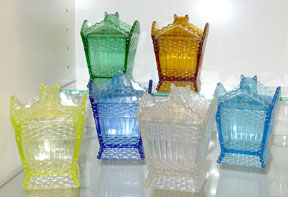 |
On the left are six different colors of the Greentown pattern Basket with Cover Tall Cat on Hamper. Probably made in the first few years of the 20th Century, all are difficult to find. |
| The Basket Nappy & Cover on the Right is also called
the Low Cat on Hamper. (a canary one brought $1750 at auction in Dec,
2006) The Buffalo novelty paperweight was a product inspired by the Pan American Exposition of 1901 in Buffalo, NY. |
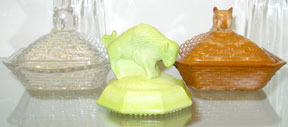 |
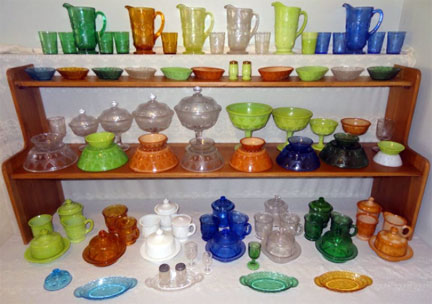 |
| This photo of a nearly complete collection of Greentown's Teardrop & Tassel has been generously donated to this site by Rick Miller. The middle row shows 7 master berry bowls turned up side down w/ their matching sauce dish on top of them. The pieces of the pattern in milk glass are insanely rare! |
Dr. James Measell and the NGGA have completed a, comprehensive book on Greentown glass.
Go HERE to purchase & read all about it.
To learn more about Greentown Glass, check
out the NGGA
website. It has been wonderfully updated to find pictures
to help you identify the patterns made by the company. Representative
colors are also
illustrated
and you can access our application form and join this club which tries
to help others learn more about this wonderful 100-year-old glass from
central Indiana. |
 |
 |
 |